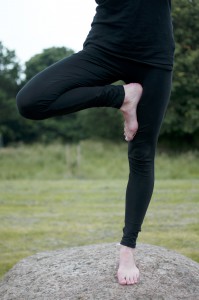Gravity, grounding, letting go…
Emma Lovell Yoga
This content shows Simple View
Category Archives ground

Falling

In her article ‘Addressing the fear of falling in seniors‘, Katy Bowman discusses how a fear of falling (and not being able to get back up) and can actually cause people to fall:
‘Most of us can relate. If you’ve ever walked over a slippery surface or spent any time on ice or snow, chances are you’ve caught yourself altering your movement patterns to prevent a fall; the alteration is a natural response to fear. But if this response is natural, how can it eventually lead to a fall?
It turns out that fear-induced alterations in gait patterns can have a profound impact on the muscles used while walking. Timid walking tends to mean less clearance of the foot from the ground (shuffling), bent knees to lower the center of mass and a reduction in the natural arm swing that balances the movement of the legs.
Being afraid of falling every now and then is no big deal. But being afraid whenever you are walking can reduce the loads to the muscles of the hip, eventually atrophying them to the point where they no longer stabilize the weight of the body as it is moving. Combine instability and poor mobility with a crack in the sidewalk or the unexpected object in the kitchen and you’ve got yourself a fall.’
Take a look at this guy taking the fear out of falling:
‘No one wants to be That Guy who has fallen and can’t get up. The reality, though, is that with beds, couches and chairs abundant, many people have lost the strength to get off the floor because they just don’t get down there anymore. As simple as it sounds, getting down and back up again requires joint mobility and muscular strength.’ Katy Bowman from ‘Addressing the fear of falling in seniors.’

You may have seen the new BBC series How to Stay Young and the sit to stand test they featured. This week’s classes have been based around building strength in the legs and mobility in the hips to enable a more easeful transition from sitting on the ground to standing. Here is the test:
A lot of people struggle to do this movement (see quote above) and so it can be helpful to modify the exercise by using the hands to start with or by lifting the hips up higher than the feet. For example you could start by standing without hands from a chair and then gradually lower the height you are starting from. Also try starting in a different position- try standing from a kneeling position or even a squat and then try coming up with hands, with one hand, and then with no hands.

More importantly, as a longer term measure to build strength, flexibility, coordination, and balance, think about sitting on the floor more often and varying how you are sitting. If sitting on the floor is uncomfortable, add cushions, blocks , or whatever is needed under the pelvis to help take away any tension in the low back or hips.
Click here for details on my ‘Happy Hips’ workshop.
For more inspiration on dynamic living spaces, or just increasing your daily movement, I recommend taking a look at the video here.
(‘Crouch’, ‘Gaze’ and ‘Fall III’ artwork from Claire Cansick)
Crawling
(via Jules Mitchell)
How’s your balance?
‘Balance is not something you find, it’s something you create.’ Jana Kingsford
Balancing can improve your focus, strength, and help to calm the mind. Yet as we age our ability to balance is something that can start to decline. In a yoga class balancing poses can be some of the quietest and most focused moments of the class. However, unless approached in a certain way, they can also become one of the most frustrating and tense times.
Here are some hints for better balancing, and ideas to practice at home:
Gaze
When trying to balance, where you look is really important. In yoga we call this the drishti, or focused gaze. When balancing, pick a spot to focus on straight ahead that’s not going to move. Keep your gaze focused but soft on this spot.
Try this:
Try standing on one leg staring at your chosen gaze point. Then try the same thing but turn and look to your right, then left, then up and down. Notice how this affects your balance. Finally try to balance on one leg with your eyes closed.
Foundations
Think about your foundations. For standing balances, before you start take off your shoes and socks and warm up ankles with ankle circles. Then wiggle your toes and try to spread them out. Next try to move just your big toes, then try to move all the other toes without your big toes moving.
Bringing awareness into the feet can help us feel the ground through the feet and so help sense the weight shifting in the body. Try to ungrip the toes and keep the feet as relaxed as you can so that they are free to sense the ground and help you balance.
Try this:
To work on improving your balance, vary the surfaces you are standing on. Try balancing on a soft or uneven surface like a towel or foam block. Notice all the little movements your feet make as they adjust to help you balance on an unfamiliar surface.
Softness
It can be common to feel tense as you focus on trying to balance. But in fact this rigidity and tension can actually make balancing harder; it is often the rigid and brittle trees that are first to topple in a storm rather than the trees that move with the wind. A balance doesn’t have to be still- your feet and toes will be constantly moving as they readjust to keep your balance. You may even find you sway a little from side to side. So try to keep the pose soft, even if that just means releasing the back teeth or the toes. Also, keep breathing! When trying really hard to balance sometimes the breath gets held, and this will only make the body even more rigid- keep reminding yourself to breathe!
Try this:
Stand on one leg and try to keep as still as you can. Notice how this makes you feel- what sensations come up in the body, notice how easy it is to balance, notice what happens to your breath. Then see if you can soften or let go of one thing in the pose such as the shoulders, and then another, and another. Again notice how the pose now feels and how easy it is to balance, notice how much you move when the body is soft, notice how your breath changes.
Take your time
Keep it slow and work in stages- If you are unable to balance on one leg then try standing next to a wall or sturdy chair and keep one or both hands on the wall/chair until you feel comfortable to take it away. Rather than rushing to get your arms above your head in vrksasana (tree pose- see image), work from the ground up- sort out the legs first and then maybe take the arms up when you feel steady.
Try this: Make balancing part of your routine- stand on one leg when you’re brushing your teeth, for example.
For further information on my workshop on ‘balance’ please see here
The ground
Be interested in your body’s relationship to the ground. Lie on your back on the floor and explore the curves of your spine, the curves of your feet and wrists. Where does you body touch the ground and where does it lift away from the ground? First explore with your mind, visualising the curves of the body, and then use your hands to see if your your mental imagine was the same. Is there anything you could let go of to feel more grounded, less tense?
‘…gravity draws everything towards the centre of the earth. The ground interrupts us. It also gives us something to resist, in order to stand up or make adjustments.’ Joanna Sarah Avison, Yoga, Anatomy, fascia and movement.
How we react against the ground and interpret gravity is written in our bodies, our posture, our movements- we can tread heavily or step lightly. Without the ground, without something to react against, our bodies cannot function properly:

